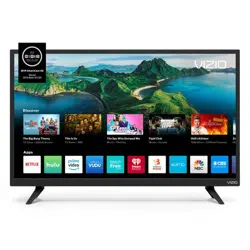Documents: Go to download!
- Owner's manual - (English)
- Getting to Know Your TV
- Completing The First-Time Setup
- Using the On-Screen Menu
- Troubleshooting
- Specifications
Table of contents
USER MANUAL Television
Getting to Know Your TV
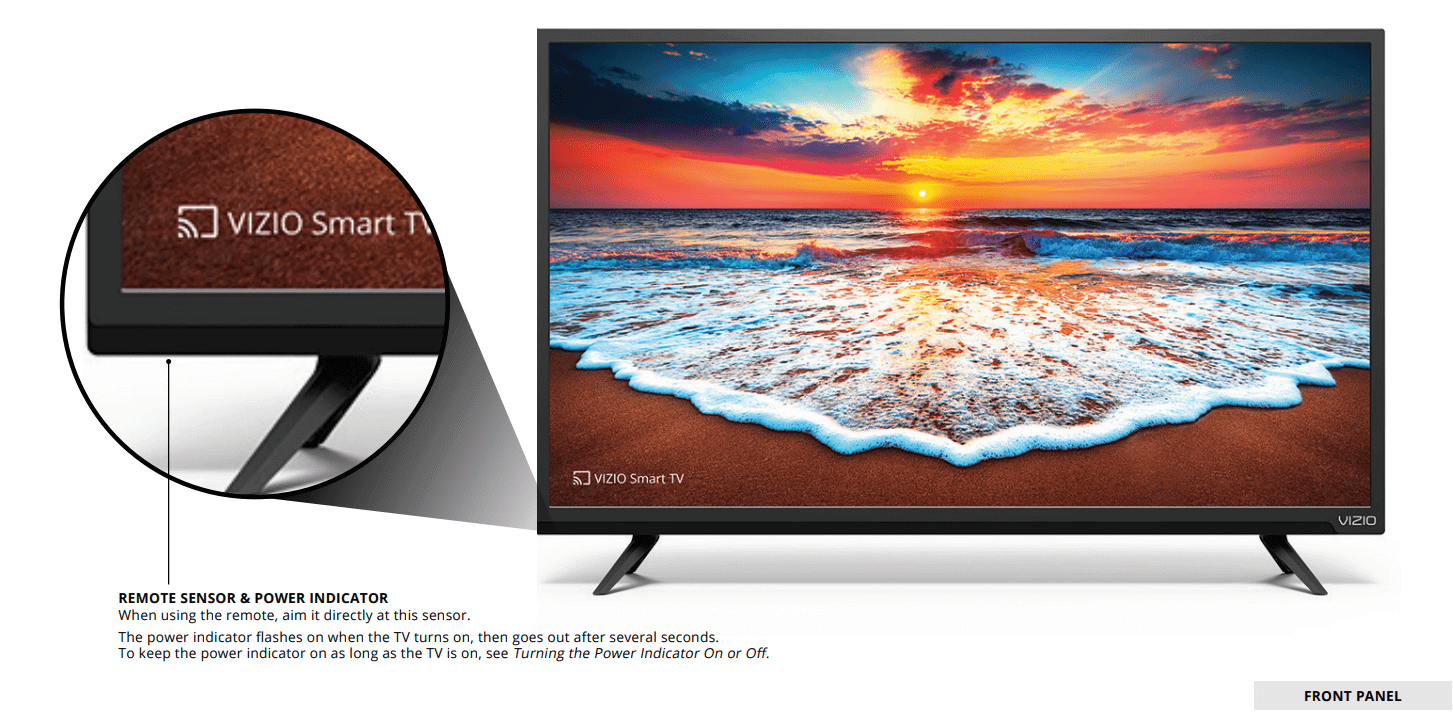
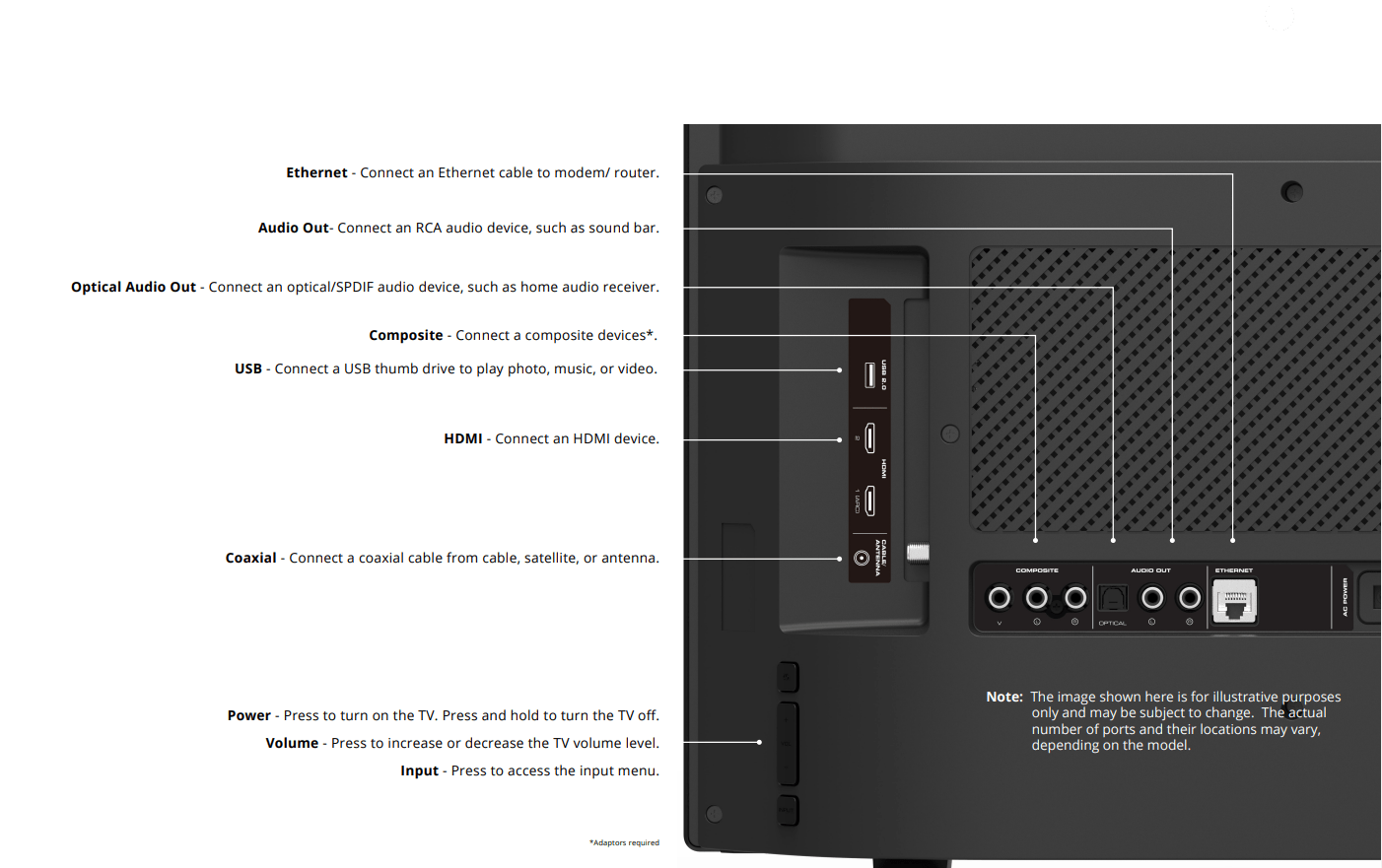
WALL-MOUNTING THE TV
To mount your TV on a wall, you will need a wall mount. Consult the information on this page to find the appropriate mount for your TV. Be sure the mount you choose is capable of supporting the weight of the TV. After you have determined that you have the correct mount for your TV, you can begin the installation. To install your TV on a wall:
|  |
USING THE REMOTE

- Input - Change the currently displayed input
- Power - Turn Television on or off
- App Launcher - Quickly launch the pictured app
- Exit - Close the on-screen menu
- Menu - Display the settings menu
- Arrow - Navigate the on-screen menus
- OK/Play/Pause - Select the highlighted menu option and play or pause content
- Back - Go to the previous on-screen menu
- Info - Display the info window
- Volume Up/Down - Increase or decrease the loudness of the audio
- Closed Caption - Open the closed caption menu.
- V Button - Launch SmartCast TV/Return to SmartCast TV Home Screen
- Pic - Cycle through the different picture setting modes
- Channel Up/Down- Change the channel.
- Mute - Turn the audio on or off
- Last - Return to the last viewed channel..
- Number Pad - Manually enter a channel
- Wide - Change the Television mode.
- Dash - Use with number pad to manually enter a digital sub-channel. (e.g. 18-4 or 18-5)
Replacing the Batteries

- Find the notch on the back of the remote. Insert a coin and pry open the back cover.
- Insert two batteries into the remote control. Make sure that the (+) and (-) symbols on the batteries match the (+) and (-) symbols inside the battery compartment.
- Replace the battery cover.
In many places batteries cannot be thrown away or discarded with household waste. Please ensure you properly dispose of your batteries consistent with the laws and/or regulations where you live. For more information please visit vizio website
Completing The First-Time Setup
The first time you turn on the TV, the on-screen instructions will guide you through each of the steps necessary to get your TV ready for use:
Before you begin the first-time setup:
- Your Television should be installed and the power cord should be connected to an electrical outlet.
- If you have a wireless network, have the network password ready
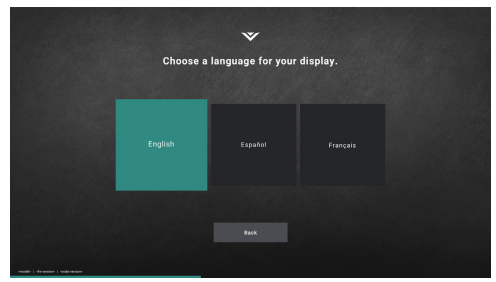 1. Choose your language. |  2. Choose home use. |
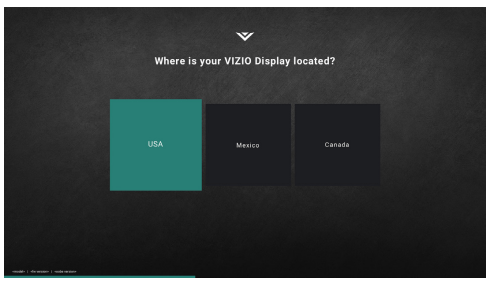 3. Choose your country. |  4. Choose your Wi-Fi and enter the password. |
 5. Name your TV. | 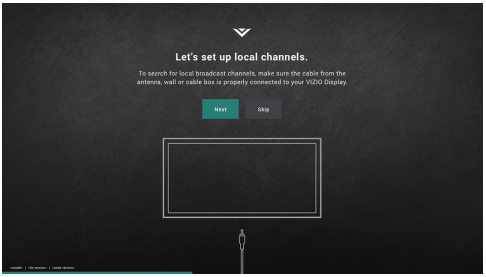 6. Scan for channels |
7. Accept the T&Cs and register your device. | |
Using the On-Screen Menu
NAVIGATING THE ON-SCREEN MENU
To open the on-screen menu, press the Menu button on the remote. Use the Arrow buttons to highlight a menu option, and press the OK button to select that option. | 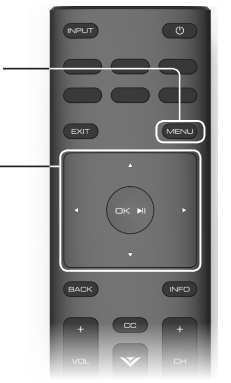 |
CHANGING THE INPUT SOURCE
External devices such as DVD players, Blu-ray Players, and video game consoles can be connected to your TV. To use one of these devices with your TV, you must first change the input source using the INPUT menu.
To change the input sources
- Press the Input button on the remote. The INPUT menu is displayed.
- Use the Right/Left Arrow buttons or the Input button on the remote to highlight the input you wish to view and press OK. The selected input is displayed.
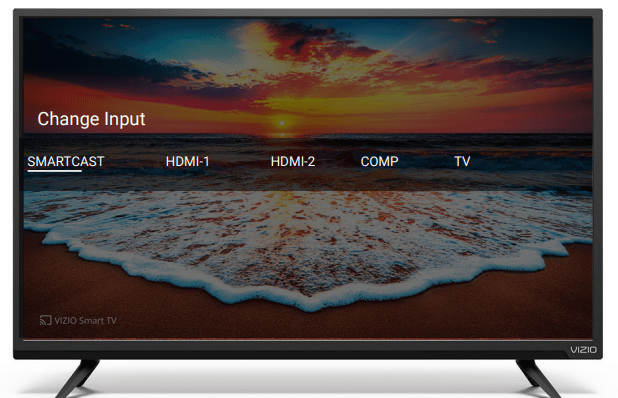
CHANGING THE SCREEN ASPECT RATIO
The TV can display images in four different modes: Normal, Panoramic, Wide, and Zoom. Each mode displays the picture differently.
Some programs have black bars on the top or sides of the picture so that the picture keeps its original shape. Examples include wide-screen movies and older television programs.
To change the screen aspect ratio:
1. Press the Wide button on the remote.
2. Use the Arrow buttons to highlight the aspect ratio you wish to view and press OK.
• Normal preserves the content’s original aspect ratio and size.
• Panoramic stretches a 4:3 aspect ratio picture to the left and right edges of the screen. The center of the image is not stretched, but the sides of the image are extremely stretched. If you are watching widescreen (1.85:1 or 2.35:1) content with black bars on the top and bottom, the black bars will still appear on the top and bottom of the TV image.
• Wide stretches a 4:3 aspect ratio picture to the edges of the screen. Since the picture is being stretched, the TV image may appear distorted—figures appear short and fat. If the program is already formatted for widescreen viewing (1.85:1 or 2.35:1), then black bars will appear on the top and bottom of the TV image.
• Zoom expands images evenly in all directions (33% taller and 33% wider) with black bars to fit the screen. A 720p image will fill a 1080p screen.
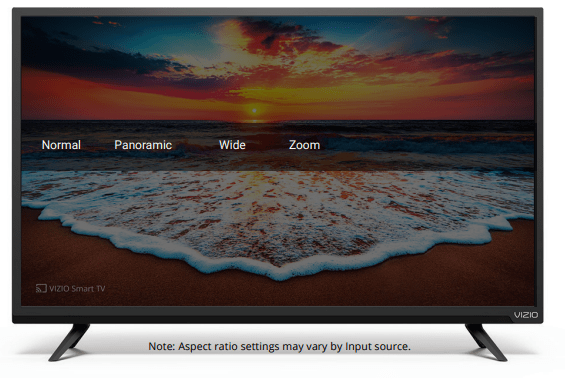
ADJUSTING THE PICTURE SETTINGS
Your TV can be adjusted to suit your preferences and viewing conditions.
To adjust the picture settings:
1. Press the Menu button on the remote. The on-screen menu is displayed.
2. Use the Arrow buttons on the remote to highlight Picture and press OK. The PICTURE menu is displayed.
3. Use the Arrow buttons on the remote to highlight Picture Mode, then use the Left/Right Arrow buttons to change the picture mode: • Standard mode sets the picture settings to the default settings. • Calibrated mode sets the picture settings to values ideal for watching TV in a brightly-lit room. • Calibrated Dark mode sets the picture settings to values ideal for watching TV in a dark room. • Vivid mode sets the picture settings to values that produce a brighter, more vivid picture. • Game mode reduces throughput delays and optimizes the picture settings for displaying game console output. • Computer mode optimizes the picture settings for displaying computer output. | 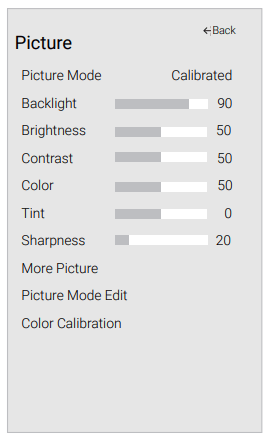 |
4. To manually change each of the picture settings, use the Up/ Down Arrow buttons on the remote to highlight that picture setting, then use the Left/Right Arrow buttons to adjust the setting:
• Backlight - Adjusts the LED brightness to affect the overall brilliance of the picture. Backlight cannot be adjusted when starting from some picture modes.
• Brightness - Adjusts the black level of the picture. When this setting is too low, the picture may be too dark to distinguish details. When this setting is too high, the picture may appear faded or washed out.
• Contrast - Adjusts the white level of the picture. When this setting is too low, the picture may appear dark. When this setting is too high, the picture may appear faded or washed out. If the setting is too high or too low, detail may be difficult to distinguish in dark or bright areas of the picture.
• Color - Adjusts the intensity of the picture colors.
• Tint - Adjusts the hue of the picture. This setting is useful in adjusting the flesh tones in the picture. If flesh appears too orange, reduce the level of color before adjusting tint.
• Sharpness - Adjusts the edge sharpness of picture elements. It can be used to sharpen non-HD (high definition) content; however, it will not produce detail that does not otherwise exist.
5. When you have finished adjusting the picture settings, press the Exit button on the remote.
Adjusting More Picture Settings
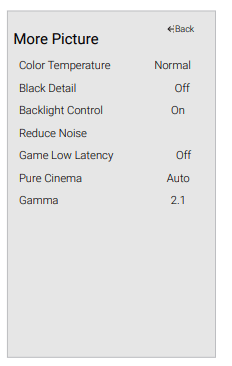
To adjust MORE PICTURE settings:
1. From the PICTURE menu, use the Arrow buttons to highlight More Picture, and then press OK.
2. Use the Arrow buttons to highlight the setting you wish to adjust, then press the Left/ Right Arrow buttons to change the setting:
• Color Temperature - See Adjusting the Color Temperature.
• Black Detail - Adjusts the average brightness of the picture to compensate for large areas of brightness. Select Off, Low, Medium, or High.
• Backlight Control - Reduces blue in scenes with fast action. Some sensitive viewers
• Reduce Noise - Opens a sub-menu with two settings.:
• Reduce Signal Noise - Diminishes artifacts in the image caused by the digitizing of image motion content. Select Off, Low, Medium, or High.
• Reduce Block Noise - Reduces pixelation and distortion for .MPEG files. Select Off, Low, Medium, or High.
• Game Low Latency - Select On to reduce video delay (lag) when gaming.
• Pure Cinema Mode - Optimizes the picture for watching film. Select Auto or Off.
• Gamma - Set the shape of the Gamma curve. Use lower Gamma values for bright room conditions, and higher values when it’s dark
3. When you have finished adjusting MORE PICTURE Settings, press the Exit button on the remote.
Adjusting the Color Temperature
Adjusting the color temperature changes the white balance of the picture. To adjust the color temperature: 1. From the MORE PICTURE menu, use the Arrow buttons to highlight Color Temperature, and then press OK. 2. Use the Arrow buttons on the remote to highlight a color temperature preset and then press OK. • Normal is optimized for television viewing. • Cool produces a blue-hued picture. • Computer optimizes the picture for use as a PC monitor. 3. When you have finished adjusting the color temperature, press the Exit button on the remote. | 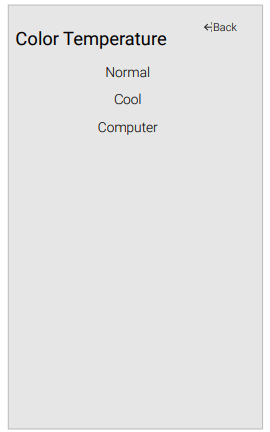 |
ADJUSTING THE AUDIO SETTINGS
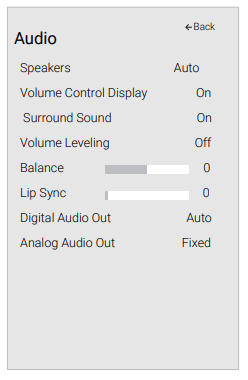
To adjust the audio settings:
1. Press the Menu button on the remote. The on-screen menu is displayed.
2. Use the Arrow buttons on the remote to highlight Audio and press OK. The AUDIO menu is displayed.
3. Use the Arrow buttons to highlight the setting you wish to adjust, then press Left/ Right Arrow buttons to change the setting:
• Speakers - Turns the built-in speakers On or Off.
• Volume Control Display - Toggle between On or Off to hide or display the on-screen volume slider that appears when volume is adjusted.
• Surround Sound - Surround sound uses DTS TruSurround™ to deliver an immersive surround sound experience from the TV’s internal speakers. TruSurround completes the entertainment experience by providing deep, rich bass and by delivering crisp details and clear, intelligible dialog. Select On or Off.
• Volume Leveling - Volume leveling uses DTS TruVolume™ to maintain consistent volume levels during transitions between program content, AV formats, and input sources. Select On or Off. In a few cases, volume leveling may artificially suppress volume increases, making it difficult to hear dialog or flattening sudden noises. If this occurs, turn volume leveling off.
• Balance - Adjusts the loudness of the audio output from the left and right speakers.
• Lip Sync - Adjusts the synchronization between the TV image and the accompanying audio track.
• Digital Audio Out - Changes the type of processing for digital audio out and HDMI ARC output when connected to a home theater audio system. Select Auto, PCM, Dolby D, or Bitstream.
• Analog Audio Out - Sets the volume control properties for the RCA connector when connected to a home theater audio system. Select Variable if you are controlling the volume with the TV’s volume controls, or select Fixed if an external audio device (sound bar or AV receiver) will control the volume.
4. When you have finished adjusting the audio settings, press the Exit button on the remote.
ADJUSTING THE NETWORK SETTINGS
Your TV is Internet-ready, featuring built-in high-speed WirelessNetwork.
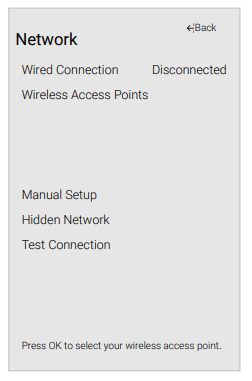
Connecting to a Wireless Network
To connect to a wireless network whose network name (SSID) is being broadcast:
- Press the Menu button on the remote. The on-screen menu is displayed.
- Use the Arrow buttons on the remote to highlight Network and press OK. The NETWORK menu is displayed.
- If you do not see your wireless network displayed, highlight More Access Points and press OK. The WIRELESS ACCESS POINTS menu, which is a list of available wireless networks, is displayed.
- Highlight the name of your wireless network (this is the network’s SSID) and press OK.
- Using the on-screeen keyboard, enter your network’s password, then highlight Connect and press OK.
- Press the Exit button on the remote.
Changing the Manual Setup Settings

Advanced users can fine-tune the network settings using the Manual Setup feature.
To change advanced network settings:
1. From the NETWORK menu, highlight Manual Setup and press OK. The MANUAL SETUP menu is displayed.
2. To change the settings manually, use the Arrow buttons on the remote to highlight DHCP and then use the Left/Right Arrow buttons to change the setting to Off.
3. Use the Arrow and OK buttons to adjust each setting:
• IP Address - The IP address assigned to the TV.
• Subnet Mask - The subnet Exit 2D
• Default Gateway - Your network’s default gateway address.
• Pref. DNS Server - Your preferred domain name server address.
• Alt. DNS Server - Your alternate domain name server address.
4. Use the Arrow buttons on the remote to highlight Save and press OK.
5. Press the Exit button on the remote.
Troubleshooting
HELP TOPICS
The remote is not responding.
• Make sure the batteries are properly inserted matching the - and + symbols.
• Replace the batteries with fresh ones.
The TV displays “No Signal.”
• Press Input button on the remote control to select a different inpput source.
• If you are using cable TV or antenna connected directly to the TV, scan for channels. See Scanning for Channels.
There is no power.
• Ensure the TV is plugged into a working electrical outlet.
• Ensure the power cable is securely attached to the TV.
• Press the Power/Standby button on the remote or on the back of the TV to turn the TV on.
The power is on, but there is no image on the screen.
• Ensure all cables are securely attached to the TV.
• Ensure all devices are connected correctly. Devices differ; see your device’s user manual for details.
• Adjust Brightness, Contrast, or Backlight. See Adjusting the Picture Settings.
• Press the Input button on the remote to select a different input source.
I see “noise” or static on the screen.
• When your TV’s digital capabilities exceed a digital broadcast signal, the signal is up-converted (improved) to match your TV’s display capabilities. This up-converting can sometimes cause irregularities in the image.
• If you are using an antenna, the signal strength of the channel may be low. Ensure your antenna is connected securely to the TV and move the antenna around the room or close to a window for the best signal.
There is no sound.
• Press Volume Up on the remote control.
• Press the Mute button on the remote to ensure mute is off.
• Check the audio settings. See Adjusting the Audio Settings.
• Check the audio connections of external devices (Blu-ray player, game console, cable/satellite box) that are connected to the TV.
• If you are using an antenna, the signal strength of the channel may be low. Ensure your antenna is connected securely to the TV and move the antenna around the room or close to a window for the best signal.
The sound is flat or dialog is not audible.
• Turn off Volume Leveling. See Adjusting the Audio Settings.
The colors on the TV don’t look right.
• Adjust the Color and Tint settings in the Picture menu. See Adjusting the Picture Settings.
• Select a pre-set picture mode. See Adjusting the Picture Settings. VIZIO recommends selecting Calibrated.
• Check all cables to ensure they are securely attached.
The buttons on the remote aren’t working.
• Ensure you are only pressing one button at a time.
• Point the remote directly at the TV when pressing a button.
• Replace the remote batteries with new ones. See Replacing the Batteries.
The image quality is not good.
• For the best image quality, view high-definition programs using digital sources. Connect your devices with HDMI cables.
• If you are using an antenna, the signal strength of the channel may be low. Ensure your antenna is connected securely to the TV and move the antenna around the room or close to a window for the best signal.
The picture is distorted.
• Move the TV away from electrical appliances, cars, and fluorescent lights.
• Ensure all cables are securely attached.
The TV image does not cover the entire screen.
• If you are using TV, AV, or Component with 480i input, press the  button on the remote to change the screen mode.
button on the remote to change the screen mode.
The TV has pixels (dots) that are always dark.
• Your HD TV is precision-manufactured using an extremely high level of technology. However, sometimes pixels may not display correctly. These types of occurrences are inherent to this type of product and do not constitute a defective product.
When I change input source, the TV image changes size.
• The TV remembers the viewing mode on each input source. If the viewing mode on the new input source differs from the one on the input source you switch from, the difference may be noticeable.
• See Changing the Screen Aspect Ratio.
How do I watch Cable/Antenna TV channels?
• If you subscribe to cable or satellite, simply connect an HDMI cable (not included) to the receiver.
• If you use external antennas to watch local broadcast channels, connect via coaxial.
How do I change the Inputs?
• Press the Input button on the back of the TV to cycle through the Inputs.
• Press the Input button on the remote to cycle through the Inputs.
• If the VIZIO SmartCast™ App is installed on your phone or tablet, open the VIZIO SmartCast™ App. Tap on the Device list and select your TV. Tap on the Input key and select the Input of your choice
How do I connect to my Wi-Fi network?
• On your remote, press the Menu button then go to Network → Select your Wi-Fi name → Enter password.
• If the VIZIO SmartCast™ App is installed on your phone or tablet, open the VIZIO SmartCast™ App. Tap on the device list and select your TV. Tap on the Settings icon → Network → Wireless Access Points. Select your Wi-Fi network from the list, enter the Wi-Fi password, and tap Connect.
How do I stream apps like Netflix and Youtube to my VIZIO SmartCast™ TV?
• Launch SmartCast TVSM. Press the V Logo button (  ) on your remote or select SmartCast from the list of inputs.
) on your remote or select SmartCast from the list of inputs.
• Download and open a Chromecast-enabled apps on your mobile device, such as like Netflix or Youtube. Then tap the Cast button.
How do I exit Demo Mode?
• Press and hold the Input button on the back of the TV to exit the demo mode
How do I download the VIZIO SmartCast™ App?
• Make sure your phone or tablet is connected to a Wi-Fi network. Open a browser on your phone or tablet. Navigate to vizio.com/smartcastapp and follow the on-screen instructions to download the VIZIO SmartCast™ App.
Specifications

See other models: E390-A1 E291i-A1 E390-B1 E28h-C1 D50-F1

